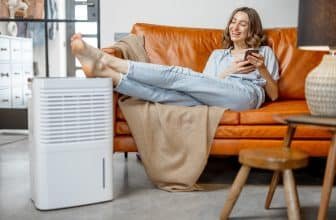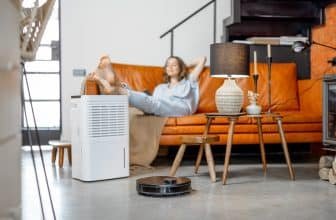Safety Concerns and Regulations for Ozone Air Purifiers: Health Risks and Standards
Ozone air purifiers have been marketed as a way to improve indoor air quality and reduce allergens, but they pose potential health risks that should not be ignored. Ozone, a molecule consisting of three oxygen atoms, can irritate the respiratory system and trigger asthma attacks. Prolonged exposure to elevated levels of ozone can have more severe health effects.
The Environmental Protection Agency (EPA) has issued a warning against using ozone generators as air cleaners, citing the potential health risks associated with ozone exposure. Public health agencies do not recommend the use of ozone-generating air purifiers due to these potential health risks. Despite this warning, some manufacturers continue to market ozone air purifiers as effective air cleaners, which can mislead consumers into thinking that they are safe to use.
To ensure that ozone air purifiers are safe to use, it is important to understand the applicable safety standards and regulations. In the United States, the Occupational Safety and Health Administration (OSHA) has established permissible exposure limits (PELs) for ozone. The EPA has also established National Ambient Air Quality Standards (NAAQS) for ozone. These standards help ensure that ozone exposure levels are kept within safe limits.
Key Takeaways
- Ozone air purifiers can pose potential health risks and are not recommended by public health agencies.
- The Occupational Safety and Health Administration (OSHA) and the Environmental Protection Agency (EPA) have established safety standards and regulations for ozone exposure.
- Consumers should be aware of the potential health risks associated with ozone air purifiers and ensure that they are using them safely within the established safety standards and regulations.
Understanding Ozone and Its Uses
Ozone is a gas that is composed of three oxygen atoms, which is a naturally occurring gas in the Earth’s atmosphere. It is also produced by electrical discharges, such as lightning, and by ultraviolet light from the sun. Ozone is a highly reactive gas that can be both beneficial and harmful to human health, depending on the concentration and duration of exposure.
Properties of Ozone
Ozone is a strong oxidizing agent that can react with and break down many organic and inorganic compounds. It is a powerful disinfectant that can kill bacteria, viruses, and other microorganisms. However, ozone is also a toxic gas that can cause respiratory problems, eye irritation, and other health effects at high concentrations.
The concentration of ozone that is safe for human exposure depends on the duration of exposure and the individual’s sensitivity to the gas. The US Environmental Protection Agency (EPA) has established a National Ambient Air Quality Standard (NAAQS) for ozone, which limits the concentration of ozone in outdoor air to 0.075 parts per million (ppm) averaged over an 8-hour period.
Applications of Ozone Generators
Ozone generators are devices that produce ozone by using electrical discharges or ultraviolet light. These devices are commonly used in air purifiers, water treatment systems, and other applications where the disinfectant properties of ozone are desired.
However, the use of ozone generators in indoor environments has raised concerns about the potential health risks of ozone exposure. The EPA has issued a warning against the use of ozone generators as air purifiers, stating that they can produce harmful levels of ozone that can cause respiratory problems and other health effects.
To ensure the safety of indoor air quality, the EPA has established a set of safety standards and regulations for ozone generators. These regulations limit the concentration of ozone that can be produced by these devices and require that they be used only in well-ventilated areas.
In conclusion, ozone is a gas that can be both beneficial and harmful to human health. While ozone generators have many useful applications, they can also pose a risk to indoor air quality if not used properly. It is important to follow safety standards and regulations when using ozone generators to ensure the safety of indoor air quality.
Health Impacts of Ozone Exposure

Ozone is a lung irritant that can cause respiratory system effects, such as coughing, shortness of breath, and chest pain. According to the US EPA, people most at risk from breathing air containing ozone include people with asthma, children, older adults, and people who are active outdoors, especially outdoor workers. In addition, people with certain genetic characteristics and people with reduced intake of certain nutrients, such as vitamins C and E, are at greater risk from ozone exposure.
Respiratory System Effects
Ozone exposure can cause a range of respiratory system effects, from mild to severe. According to the CDC, exposure to ozone may cause headaches, coughing, dry throat, shortness of breath, a heavy feeling in the chest, and fluid in the lungs. Higher levels of exposure can lead to more severe symptoms. Chronic exposure may lead to asthma.
Potential for Chronic Health Issues
The potential for chronic health issues resulting from ozone exposure is a concern. According to a study published in the PMC, ozone pollution is a major health hazard worldwide and is responsible for several hundreds of thousands of premature deaths and tens of millions of asthma-related emergency room visits annually. The study also notes that climate change, through creating atmospheric conditions favoring ozone formation, has been and will continue to increase ozone concentrations in many parts of the world.
To protect public health, the US EPA has established National Ambient Air Quality Standards for ozone. These standards set limits on the amount of ozone that is allowed in the air. In addition, the US EPA has established regulations for ozone air purifiers, including limits on ozone emissions. It is important to follow these regulations and use ozone air purifiers only as directed to minimize the potential for health risks.
Safety Standards and Regulations
Ozone air purifiers have potential health risks, and there are safety standards and regulations in place to minimize these risks. The following subsections discuss the guidelines and recommendations from various organizations.
Environmental Protection Agency Guidelines
The Environmental Protection Agency (EPA) provides guidelines for the use of ozone air purifiers. According to the EPA, ozone generators that are sold as air cleaners are not effective in controlling indoor air pollution and can be harmful to human health. The EPA recommends using air cleaners that do not generate ozone and are certified by the California Air Resources Board (CARB).
World Health Organization Recommendations
The World Health Organization (WHO) has recommended that ozone concentrations in indoor air should not exceed 100 µg/m3 for prolonged periods. Exposure to high levels of ozone can irritate the respiratory system, leading to coughing, chest pain, and shortness of breath. It can also worsen existing respiratory conditions such as asthma. Therefore, the WHO recommends that the use of ozone-generating air purifiers be avoided.
California Air Resources Board Standards
The California Air Resources Board (CARB) has established safety standards for ozone air purifiers. CARB has set a limit of 0.05 parts per million (ppm) of ozone emission for indoor air cleaning devices. This limit is based on health standards and is designed to protect the public from harmful exposure to ozone.
It is important to note that ozone air purifiers are not regulated by the Food and Drug Administration (FDA) as medical devices. Therefore, it is crucial to follow the safety guidelines and regulations set by organizations such as the EPA, WHO, and CARB to minimize the potential health risks associated with the use of ozone air purifiers.
In conclusion, ozone air purifiers have potential health risks, and it is crucial to follow the safety standards and regulations set by various organizations to minimize these risks. The EPA recommends using air cleaners that do not generate ozone and are certified by CARB. The WHO recommends avoiding the use of ozone-generating air purifiers, and CARB has established safety standards for ozone air purifiers.
Evaluating Ozone Air Purifier Safety

Ozone air purifiers, also known as ozone generators, are marketed as devices that can improve indoor air quality by removing pollutants and odors. However, there are potential health risks associated with the use of these devices, and regulations have been put in place to ensure their safety.
Assessing Ozone Emission Levels
Ozone is a gas that can be harmful to human health when inhaled in high concentrations. The California Air Resources Board (CARB) has set a limit of 0.05 parts per million (ppm) for indoor ozone levels, which is considered safe for human exposure. The Environmental Protection Agency (EPA) has also warned that ozone generators can produce high levels of ozone, which can be harmful to human health.
To ensure the safety of ozone air purifiers, it is important to assess their ozone emission levels. The Association of Home Appliance Manufacturers (AHAM) has established a voluntary certification program for air cleaners, including ozone generators. This program requires manufacturers to test their products and provide information on their ozone emission levels.
Understanding Air Cleaner Certification
The AHAM certification program for air cleaners includes three different ratings: Clean Air Delivery Rate (CADR), Energy Star, and AHAM Verifide. The CADR rating measures the effectiveness of the air cleaner in removing pollutants such as smoke, dust, and pollen from the air. The Energy Star rating indicates that the air cleaner meets energy efficiency guidelines set by the EPA. The AHAM Verifide rating indicates that the air cleaner has been independently tested and verified to meet certain performance standards.
When evaluating the safety of ozone air purifiers, it is important to look for products that have been certified by AHAM. The AHAM Verifide rating ensures that the product has been independently tested and verified to meet certain performance standards, including safe ozone emission levels. Additionally, consumers should look for products that have a low CADR rating for ozone, indicating that the product produces low levels of ozone.
In conclusion, while ozone air purifiers can be effective at removing pollutants and odors from indoor air, they can also pose potential health risks. It is important to assess their ozone emission levels and look for products that have been certified by AHAM to ensure their safety.
Best Practices for Ozone Air Purifier Usage
When using an ozone air purifier, it is important to follow the appropriate settings and conditions, as well as maintenance and operation guidelines to ensure safe and effective use. Here are some best practices to consider:
Appropriate Settings and Conditions
Ozone air purifiers should only be used in unoccupied spaces, as exposure to high levels of ozone can cause health problems. The California Air Resources Board (CARB) recommends that ozone generators not be used in occupied spaces, and the US Environmental Protection Agency (EPA) warns against the use of ozone generators as air cleaners.
When using an ozone air purifier, it is important to follow the manufacturer’s instructions for appropriate settings and conditions. Some ozone air purifiers have adjustable settings for ozone output, and it is important to use the lowest effective setting to minimize exposure to ozone.
It is also important to consider ventilation when using an ozone air purifier. Adequate outdoor air ventilation can help to reduce indoor air pollution and minimize exposure to ozone. If possible, open windows and doors to increase ventilation while using an ozone air purifier.
Maintenance and Operation Guidelines
Regular maintenance of an ozone air purifier is important to ensure effective and safe operation. The manufacturer’s instructions should be followed for cleaning and maintenance of the ozone air purifier.
It is also important to regularly replace the ozone generator plates or cells, as these can become dirty and less effective over time. The manufacturer’s instructions should be followed for replacement of these parts.
When using an ozone air purifier, it is important to monitor the ozone levels in the air. Ozone levels can be monitored using an ozone meter, which can be purchased online or at a hardware store. It is important to use an ozone meter to ensure that ozone levels do not exceed safe levels.
In summary, ozone air purifiers should only be used in unoccupied spaces, and the lowest effective setting should be used to minimize exposure to ozone. Adequate outdoor air ventilation should be provided, and regular maintenance and monitoring of ozone levels are important for safe and effective use.
Alternatives to Ozone Air Purifiers
When it comes to air purifiers, there are alternatives to ozone air purifiers that can be just as effective without the potential health risks. Some of the most popular alternatives include HEPA filters, activated carbon filters, ionizers, and electrostatic precipitators.
HEPA Filters and Their Advantages
HEPA filters are one of the most common types of air purifiers on the market. They work by trapping small particles in the air, such as dust, pollen, and pet dander. HEPA filters are highly effective at removing these types of particles and can help improve indoor air quality.
One of the advantages of HEPA filters is that they do not produce any harmful byproducts, such as ozone. HEPA filters are also relatively easy to maintain and do not require any special cleaning or maintenance.
Activated Carbon Filters
Activated carbon filters are another popular alternative to ozone air purifiers. These filters work by using activated carbon to absorb odors and other pollutants in the air. Activated carbon filters are highly effective at removing odors and can be a great option for those with pets or who live in areas with high levels of pollution.
One of the advantages of activated carbon filters is that they do not produce any harmful byproducts, such as ozone. They are also relatively low maintenance and can be easily replaced when necessary.
Ionizers and Electrostatic Precipitators
Ionizers and electrostatic precipitators are two other types of air purifiers that can be effective at removing pollutants from the air. Ionizers work by releasing negatively charged ions into the air, which attract positively charged particles and cause them to stick to surfaces in the room. Electrostatic precipitators work in a similar way, but use an electric charge to remove particles from the air.
One of the advantages of ionizers and electrostatic precipitators is that they do not produce any harmful byproducts, such as ozone. However, they can be less effective than other types of air purifiers at removing certain types of pollutants, such as odors.
Overall, there are several alternatives to ozone air purifiers that can be just as effective at improving indoor air quality without the potential health risks. When choosing an air purifier, it is important to consider the specific needs of your home and family, as well as any applicable safety standards and regulations.
Conclusion
In conclusion, while ozone air purifiers may seem like a great way to clean the air in your home or office, they come with potential health risks. Exposure to high levels of ozone can irritate the respiratory system, leading to coughing, chest pain, and shortness of breath. It can also worsen existing respiratory conditions such as asthma. Public health agencies do not recommend the use of ozone-generating air purifiers due to these potential health risks.
To ensure the safety of consumers, there are safety standards and regulations in place for ozone air purifiers. The US EPA has established safety standards for ozone generators that are sold as air cleaners. According to the EPA, ozone concentrations would have to be 5 – 10 times higher than public health standards allow before the ozone could decontaminate the air sufficiently to prevent survival and regeneration of biological organisms.
It is important to note that ozone air purifiers are not very effective at cleaning the air. While they may remove some indoor air contaminants, they can only do this at concentrations that are so high, they violate public health standards. Some ozone air purifiers produce so much ozone that they cause ozone buildups that would trigger severe smog alerts for outdoor air.
Overall, it is important to prioritize health and safety when choosing an air purifier. Consumers should opt for air purifiers that meet safety standards and regulations and are effective at removing indoor air contaminants without producing harmful byproducts.
Frequently Asked Questions
What are the potential health risks associated with using ozone air purifiers?
Ozone air purifiers can produce ozone, a gas that can be harmful to humans when inhaled in large quantities. Exposure to high levels of ozone can irritate the respiratory system, leading to coughing, chest pain, and shortness of breath. It can also worsen existing respiratory conditions such as asthma. Public health agencies do not recommend the use of ozone-generating air purifiers due to these potential health risks.
What safety standards must ozone air purifiers meet to be considered safe for use?
Ozone air purifiers must meet safety standards set by regulatory bodies like the Environmental Protection Agency (EPA) and the California Air Resources Board (CARB). The EPA has issued guidelines for indoor air quality, which include recommendations for safe ozone levels. CARB has established regulations that limit the amount of ozone that can be produced by air purifiers sold in California.
How can exposure to ozone from air purifiers be treated?
If someone has been exposed to high levels of ozone from an air purifier, they should immediately move to an area with fresh air and seek medical attention if they experience symptoms such as coughing, chest pain, or shortness of breath. Treatment may include oxygen therapy or other medical interventions depending on the severity of the exposure.
What symptoms indicate ozone poisoning from an ozone generator?
Symptoms of ozone poisoning from an ozone generator can include coughing, shortness of breath, chest pain, and throat irritation. In severe cases, it can lead to pulmonary edema, which is a buildup of fluid in the lungs.
What precautions should be taken when operating an ozone generator in a home?
When operating an ozone generator in a home, it is important to follow the manufacturer’s instructions carefully. The generator should be placed in an area with good ventilation and away from people and pets. It is also recommended to use a timer to limit the amount of time the generator is in use.
Are there any regulations governing the use of ozone generators in residential settings?
Yes, there are regulations governing the use of ozone generators in residential settings. For example, the EPA has issued guidelines for indoor air quality, which include recommendations for safe ozone levels. CARB has established regulations that limit the amount of ozone that can be produced by air purifiers sold in California. It is important to check with local and state authorities for regulations specific to your area.






